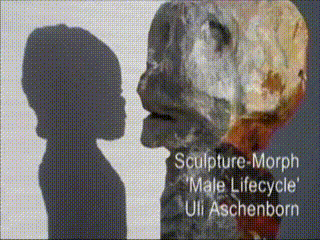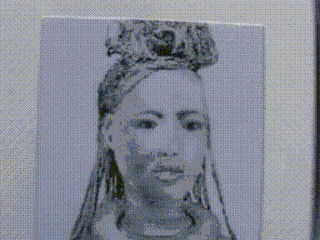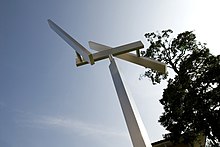Kinetic art


Kinetic art is a form of expression in which movement is considered as an integral aesthetic component of the art object. Even when the object seems to change because the viewer is moving (see the artist Carlos Cruz-Diez and below the video of Uli Aschenborn 's female image ) or an illusion fakes movement ( Youri Messen-Jashin ). Therefore, Op Art is considered kinetic art by some viewers.
history
Kinetic art became popular in the 1950s and 1960s. Its premodern origins lie in the mechanical arts and crafts and aesthetic water features of the Baroque era . Its beginnings in modernity can be found in the kinetic objects of light and movement by Marcel Duchamps and Man Rays as well as in the constructivist machines of the artists Wladimir Tatlin , Naum Gabo , Alexander Rodtschenko and László Moholy-Nagy . Some artists, such as Alexander Calder and Jean Tinguely, also work with found materials and objects, thus continuing the concept of the objet trouvé . A continuation of kinetic art is cybernetic art , in which the work of art reacts to external influences, in particular to the manipulation of people (e.g. Nicolas Schöffer's Spatiodynamic Towers ).
The technical constructions are often driven by the natural forces of wind (see mobile ), water and gravity (see marble runs ). But motors (see video of the sculpture by Uli Aschenborn ), clockworks and manual drives are also used. Today's artists of kinetic art are often on the cutting edge of technology, computer-controlled objects are no longer uncommon.
Representatives of kinetic art (selection)
Main representative
Other representatives
- David Ascalon
- Uli Aschenborn
- Anton Berger
- Marc van den Broek
- Siegfried Cremer
- Carlos Cruz-Diez
- Charly-Ann Cobdak
- Gianni Colombo
- Friedel Deventer
- Hugo Demarco
- Milan Dobeš
- Bernward Frank
- Arthur Ganson
- Rolf Glasmeier
- Gerhard von Graevenitz
- Franz Gsellmann
- Günter Haese
- Jeppe Hein
- Michael Hischer
- Gernot Huber
- Irma Hünerfauth
- Theo Jansen
- Klaus Kammerichs
- Hans-Michael Kissel
- Gyula Kosice
- Piotr Kowalski
- Harry Kramer
- Julio Le Parc
- Gereon Lepper
- Kenneth Martin
- David Medalla
- Youri Messen-Yashin
- Hans Walter Müller
- Christian Nienhaus
- Lev V. Nussberg
- Alejandro Otero
- Willi Reiche
- Karl-Ludwig Schmaltz
- Hein sinking
- Curt Stenvert
- Takis
- Paul Talman
- Christian Tobin
- Günter Tollmann
- Per Olof Ultvedt
- Hanns-Martin Wagner
- Jörg Wiele
Artist groups
- the group of artists Groupe de Recherche d'Art Visuel
- the artist group ZERO with its founding members Otto Piene , Heinz Mack , Hans Salentin and Günther Uecker .
Collections
- Kinetic department in the Art Museum Gelsenkirchen . The collection, which has been built up since the 1960s, is one of the largest in Europe.
- The MAD Museum in Stratford-upon-Avon presents only Mechanical Art and Design
literature
- Hans-Jürgen Buderer: Kinetic Art. Concepts of movement and space (= Heidelberg art-historical treatises. NF 19). Wernersche Verlagsgesellschaft, Worms 1992, ISBN 3-88462-066-5 (also: Heidelberg, University, dissertation, 1986).
Web links
Individual evidence
- ↑ Susanna Partsch : 101st most important questions - modern art , 2nd revised edition. Munich: Beck, 2016, ISBN 3-406-51128-7 , p. 56 ( preview ).
- ↑ Björn Schülke




